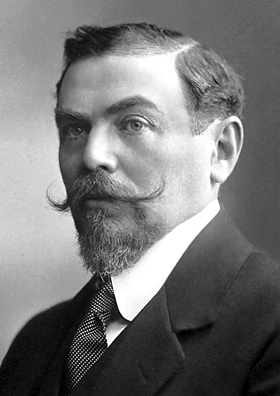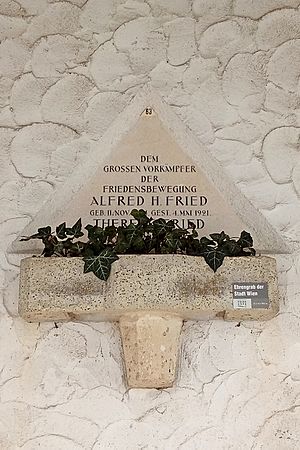Alfred Hermann Fried facts for kids
Quick facts for kids
Alfred Hermann Fried
|
|
|---|---|
 |
|
| Born | 11 November 1864 |
| Died | 5 May 1921 (aged 56) Vienna, First Austrian Republic
|
Alfred Hermann Fried (born November 11, 1864 – died May 4, 1921) was an important person from Austria. He was a pacifist, which means he believed in solving problems without war. He was also a writer and journalist.
Alfred Fried helped start the peace movement in Germany. He won the Nobel Peace Prize in 1911, sharing it with Tobias Asser. He was also a big supporter of Esperanto, a language created to help people from different countries communicate easily. He even wrote books to teach Esperanto.
His Life and Work for Peace
Alfred Fried was born in Vienna, which was then part of Austria-Hungary. He left school when he was 15 years old and started working in a bookshop. In 1883, he moved to Berlin, Germany. There, he opened his own bookshop in 1887.
A famous book called Die Waffen nieder! (which means Lay Down Your Arms!) was published in 1889 by Bertha von Suttner. This book was about peace. After reading it, Alfred Fried and Bertha von Suttner started a magazine with the same name in 1892. In this magazine, and later in another one called Die Friedenswarte (The Peace Watch), he wrote about his ideas for peace.
In 1892, he helped create the German Peace Society. This group worked to stop wars. Alfred Fried had a big idea: he thought there should be a worldwide organization to make sure countries stayed peaceful. This idea later helped create the League of Nations after World War I. After World War II, this idea led to the UN, which still works for peace today.
Alfred Fried was also very active in the Esperanto movement. He believed that if people from different countries could talk to each other easily, it would help prevent misunderstandings and wars. In 1903, he published a book called Lehrbuch der internationalen Hilfssprache Esperanto (Textbook of the International Language Esperanto).
In 1911, Alfred Fried received the Nobel Peace Prize. This was a huge honor for his work promoting peace around the world.
During World War I, Alfred Fried moved to Switzerland. Switzerland was a neutral country, meaning it did not take sides in the war. From there, he continued to speak out for peace. He passed away in his hometown of Vienna in 1921. His ashes are buried at Feuerhalle Simmering.
What He Wrote
Alfred Fried wrote many books and articles about peace and international understanding. He also focused on the Esperanto language.
- Wörterbuch Esperanto-Deutsch und Deutsch-Esperanto (Esperanto-German and German-Esperanto Dictionary)
- Lehrbuch der internationalen Hilfssprache “Esperanto” (Textbook of the International Language Esperanto) – This book was first published in 1903 and had several new editions.
See Also
 In Spanish: Alfred Hermann Fried para niños
In Spanish: Alfred Hermann Fried para niños
- List of Jewish Nobel laureates
- List of peace activists
- List of Austrian Jews
- List of Austrian writers
- List of Austrians


